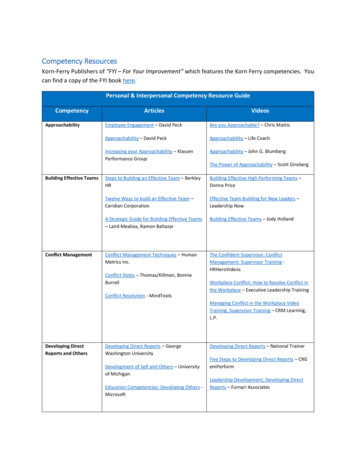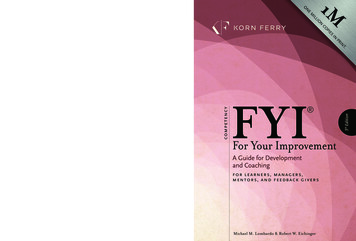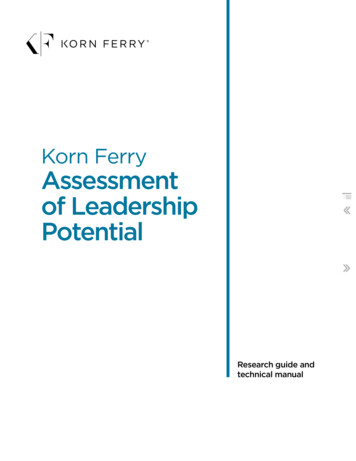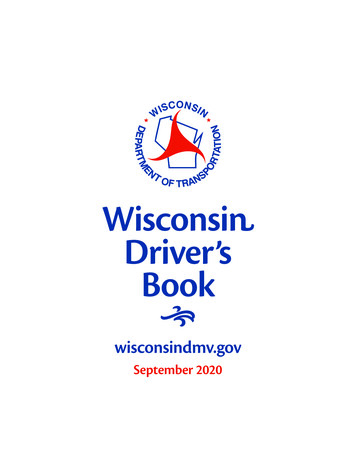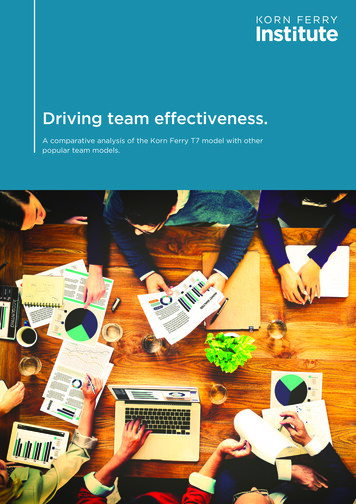
Transcription
Driving team effectiveness.A comparative analysis of the Korn Ferry T7 model with otherpopular team models.
Driving team effectiveness.“Not finance. Not strategy. Not technology. It isteamwork that remains the ultimate competitiveadvantage, both because it is so powerful and sorare (p. vii).”This is the way Patrick Lencioni opened his best-selling book, The FiveDysfunctions of a Team (2002). It has been estimated that nearly allof the Fortune 500 companies employ teams of some form or type intheir business (see Dumaine, 1994; Kirkman, Gibson, & Shapiro, 2001).Increasingly, teams are being used in a variety of applications by awide range of organizations (e.g., project teams, virtual task forces,quality circles, self-directed work teams, standing committees).The importance of work teams appears to be gaining in strength asjobs get bigger, organizational structures get more complex, and moreand more companies become multi-national in scope (Naquin & Tynan,2003). In today’s corporate environment, it appears the team—not theindividual—holds the key to business success.Key takeaways. The Korn Ferry T7 Model of Team Effectiveness was validatedusing 303 teams (3,328 participants) in 50 organizations acrossa variety of industry sectors. Overall, two conclusions are apparent. First, the six modelsof team effectiveness reviewed in this whitepaper have muchsimilarity in the manner in which they view team functioning.Second, the Korn Ferry T7 Model is one of the most (if notthe most) comprehensive assessments of team effectivenessin the literature.2What’s inside.03 Teams in thecontemporary workplace.04 Frequently citedteam models.07 Other models of teameffectiveness in theliterature.12 Summary of the modelsof team effectiveness.14 The secret to successfulteams.15 References.
Driving team effectiveness. Teams in the contemporaryworkplace.As companies restructure, downsize,and reinvent themselves, the newroles being created tend to be teamoriented. Organizations are becomingflatter, leaner, and more agile.A prominent feature of effectiveness today issatisfying customer needs. Many jobs and projectsare becoming increasingly complex, less timebound, and global in scope. All these factorscollectively are making it increasing difficult for oneperson to perform a single job. The contemporaryworkplace uses teams as the basic work unit(e.g., surgical units, airplane crews, researchand development teams, production crews).Although teams are ubiquitous in organizations,most employee related functions are individualized(e.g., selecting, training, evaluating, rewarding).Such a disconnect between an organization’s needto foster effective teams and its natural tendency tofocus on the individual employee can create manyproblems. In addition, some research suggests a keyreason why some teams fail is that employees areill-prepared to make the transition from individualcontributor to team member.Bergmann and De Meuse (1996) investigated theimplementation of self-managed work teams in alarge food processing plant. They observed thatemployees lacked the basic team skills of problemsolving, dealing with conflict, conducting effectivemeetings, and interpersonal communication.Eventually, the employees resisted the movementto self-managed work teams to such an extentthat management returned to the old system ofproduction after 10 months.One of the keys to developing high performingteams is to remember that successful teams donot simply happen. They take much effort andtime. They take proper guidance and support fromthe team leader. They require an organizationalculture which enables and fosters team work. Toattain a high level of team performance, we must beknowledgeable about what factors influence teamdynamics and effectiveness.In an attempt to understand how teams work,a number of authors have proposed models ofteam performance. Each of these models presentsseveral variables that the author(s) posit influencethe effectiveness of teams. Some of the modelshighlight group structure and interpersonaldynamics, while others tend to focus on the talentand motivation of individual team members. Stillothers emphasize factors external to the team itself(e.g., a company’s culture). Some models wereproposed more than three decades ago; somewere developed within the past few years.research suggests a key reason why some teams fail is thatemployees are ill-prepared to make the transition from individualcontributor to team member.3
Frequently cited team models.This whitepaper first presentsand reviews the Korn Ferry T7Model of Team Effectivenessfollowed by an examination of fivefrequently cited team models. Rubin, Plovnick, and Fry (1977). Katzenbach and Smith (1993). LaFasto and Larson (2001). Hackman (2002). Lencioni (2005).The whitepaper summarizes the differences andsimilarities between the models. As consultantsand organizational leaders, it seems as thougheach of us has our favorite team model. Wehope this investigation will provide some clarityregarding how the T7 Model compares to otherpopular team models.As we will discover, the T7 Model presents themost comprehensive framework of all the modelsreviewed. Our goal is that this paper will enable usto become more familiar and confident that suchan approach to assessing team effectiveness canoffer client organizations a powerful framework forimproving their work teams.4The T7 Model of TeamEffectiveness.In an attempt to understand how teams work,Michael Lombardo and Robert Eichinger originallydeveloped the T7 Model in 1995 to represent thekey facets that influence the performance of workteams. Based upon their review of the researchliterature, they identified five factors inside the teamand two factors outside the team which impactteam effectiveness. Each one of the factors wasnamed to begin with the letter “T.” Hence, the nameT7 Model (see Figure 1).[this] approach to assessingteam effectiveness can offerclient organizations a powerfulmeasure for improving theirwork teams. [Lombardo andEichinger] developed the T7Model in 1995 to represent thekey facets that influence theperformance of work teams.
Driving team effectiveness. FRO M THE eamingONAMUPPTORIATIZSFigure 1The T7 Model of Team Effectiveness.Trustoperateeffectivelyin eachotherTalentcollectiveskillsTEAMLE ADE RFITThe five internal team factors include: Thrust – a common purpose about what needs to be accomplished or team goal(s). Trust – in each other as teammates. Talent – the collective skills of the team members to get the job done. Teaming skills – operating effectively and efficiently as a team. Task skills – executing successfully or getting the job done.The two external team factors are: Team-leader fit – the degree to which the team leader satisfies the needs of the team members. Team support from the organization – the extent to which the leadership of the organization enablesthe team to perform.5
Each of the factors inside the team can bedelineated into sub-factors or dimensions. Forexample, “thrust” refers to agreed upon vision,mission, values, and goals among members withina team. Moreover, members employ a commonstrategy and tactics to accomplish goals.Specifically, thrust consists of the following threebehavioral dimensions: (a) thrust management,(b) thrust clarity, and (c) thrust commitment. Incontrast, “trust” includes the following dimensions:(a) trust in truthful communication, (b) trust inactions, and (c) trust inside the team. In total, thefive internal factors consist of 18 dimensions ofteam effectiveness (see Table 1 opposite).All five internal factors have to be present for teamsto be high performing. However, teams cannot behigh performing unless the necessary organizationaland leadership support also are provided. It doesnot matter how good a team is on thrust, trust,talent, teaming skills, and task skills, it must have thesupport from the organization and the leadership fitto be effective (Lombardo & Eichinger, 1995).T7 Model researchA total of 303 teams and 3,328 participants wereadministered the Team Architect assessment. Theteams were employed in 50 organizations acrossa variety of industry sectors (e.g., manufacturing,health care, telecommunications, finance). Whetherthe data were obtained from the team leader, teammembers, or were aggregated at the team level, themodel was supported (De Meuse, Tang, & Dai, 2009).In addition, the literature on teams was examinedto determine whether any additional factors anddimensions were required to capture variouscomponents of team effectiveness. Based on acomprehensive review of the relevant research, itwas found that no addition factors or dimensionswere needed (De Meuse, 2007).6Table 1Inside the Team Factors and Dimensions.Internal factorDimension Thrust management.Thrust Thrust clarity. Thrust commitment.Trust Trust in truthfulcommunication. Trust in actions. Trust inside the team.Talent Talent acquisitionand enhancement. Talent allocationand deployment. Resourcemanagement. Team learning.Teaming skills Decision making. Conflict resolution. Team atmosphere. Managing process. Focusing.Task skills Assignment flexibility. Measurement. Delivering the goods.Each of the factors inside the teamcan be delineated into sub-factorsor dimensions. For example,“thrust” refers to agreed uponvision, mission, values, and goalsamong members within a team.
Driving team effectiveness. Other models of teameffectiveness in the literature.Rubin, Plovnick, and Fry Model—The GRPI Model of TeamEffectiveness.This model by Rubin, Plovnick, and Fry (1977) isone of the oldest models of team effectiveness. It issometimes referred to as the “GRPI Model,” whichstands for Goals, Roles, Processes, and InterpersonalRelationships. The authors present their model interms of a pyramid similar to Maslow’s Hierarchyof Needs Theory (1954). However, unlike Maslow’stheory, this model starts at the top of the pyramid.The authors provide guidance for definingcomponents of the model.Goal definition. Clarity about the main purpose of the team.Agreement on the desired results.Understanding of the main tasks.Agreement on the standards andexpectations. Clarity of priorities and deadlines. Understanding of boundaries.According to the model, a team always should beginwith a team level goal. After the goal is defined,the roles and responsibilities will become clearer.As individuals work together (processes), they willsee that goals and responsibilities often are notsufficiently clear. Consequently, team members willneed to redefine them. That redefinition enablesthem to adjust and readjust team processes, such asdecision making, conflict resolution, and work flow.When doing all that, they will be developing theinterpersonal relationships needed to relate to otherteam members and the team leader. See Figure 2.Role clarification.Figure 2The GRPI Model of Team Effectiveness—Rubin, Plovnick, and Fry Model (1977) Team processes—(e.g., how decisions aremade, how the team solves problems andresolves conflict, communication). Work processes—(e.g., procedures andwork flow).GOALROLESPROCESSESINTERPERSONAL RELATIONSHIPS Acceptance of a team leader.Understand all members’ roles.Individual responsibilities.Shared responsibilities.Clear boundaries.Identify and fill gaps.Processes and workflow.Interpersonal relationships. Relating with the other team members.Trust.Sensitivity and flexibility with each other.Good communication.Collaboration in problem solving.Effective methods for dealing with conflict.7
Katzenbach and Smith Model—Focusing on team basics.Katzenbach and Smith (1993) assert most peoplerealize the capabilities of teams, but there is anatural resistance to moving beyond individual roles,responsibilities, and accountabilities. Individuals donot easily accept responsibility for the performanceof others, or cherish others assuming responsibilityfor them. Overcoming this resistance requires thatteam members understand, accept, and apply the“basics” of team work. Katzenbach and Smith depictthese team basics in the form of a triangle (seeFigure 3).There are three overarching goals in the Katzenbachand Smith (1993) model: (a) Collective WorkProducts, (b) Personal Growth, and (c) PerformanceResults. These outcomes are presented in the verticesof the triangle and indicate what teams can deliver. Incontrast, the sides and center of the triangle describethe team elements required to make it happen—Commitment, Skills, and Accountability.The authors contend that successful teams aredeeply committed to their goals, approach, andpurpose. Members in these teams also are verycommitted to each other. They understand that the“wisdom of teams comes with a focus on collectivework-products, personal growth, and performanceresults” (Katzenbach and Smith, 1993, p. 9).They assert that successful teams always are aresult of pursuing demanding performance goals atthe team level.Katzenbach and Smith (1993) pose the followingseries of six questions to diagnose the functioningof teams and enhance their effectiveness.Six questions. Is the size of the team appropriate? Do members have sufficient complementaryskills? Is the purpose of the team truly meaningfuland understood? Are there team-oriented goals—are theyclear, realistic, and measurable?Overcoming this resistance[to move beyond individualroles and responsibilities]requires that team membersunderstand, accept, and applythe “basics” of team work. Does the team have a well thought-out,articulated working approach? Is there a sense of mutual accountability?For teams to be effective, all six questions need tobe addressed satisfactorily.Figure 3Focusing on team basics—Katzenbach and Smith (1993).PERFORMANCERESULTSILSK123COLLECTIVEWORK PRODUCTSCOMMITMENT38Meaningful purposeSpecific goalsCommon approachMutualSmall number of peopleIndividualTYLIBITAUNLSCOProblem ALGROWTH
Driving team effectiveness. LaFasto and Larson Model—Five dynamics of teamworkand collaboration.LaFasto and Larson (2001) developed a modelof team effectiveness which they refer to as the“Five dynamics of team work and collaboration.”They based this model upon the insights theygleaned from investigating 600 teams in a varietyof industries. They theorize that there are fivefundamental elements or components which mustbe understood and actively managed to increase thelikelihood of team effectiveness. These elements arepresented in Figure 4.Similar to other model authors, LaFasto and Larsonprovide much definition and guidance for each of thecomponents in their model. The authors devote anentire chapter in their book to clarifying teamwork,and then offering suggestions on how to enhanceteam effectiveness for each of these five components(LaFasto and Larson, 2001).There are four necessarybehaviors for members ina team setting: (a) openness,(b) supportiveness, (c) anaction orientation, and (d)a “positive personal style.”For example, the initial element is “team member.” Akey to team success is to begin with the right people.There are four necessary behaviors for members in ateam setting: (a) openness, (b) supportiveness, (c) anaction orientation, and (d) a “positive personal style.”The model components areaddressed in the following manner. What makes a good team member—theabilities and behaviors that really matter? What behaviors in a group foster effectiveteam member relationships? What are the behaviors of teams—asperceived by their members and leaders—that cause some teams to be moresuccessful than others at problem solving? What are the behaviors of team leaders—asviewed by members of the team—that fosterteam success or failure? What organizational processes andpractices promote clarity, confidence, andcommitment in a team?Figure 4Five dynamics of teamwork and collaboration—LaFasto and Larson (2001).ORNGAI O N E N V IR OIZATNTLE A D E R S HEA MIPMENTR O B LE M S O LVINGATEILOENSRTHIA M M ME MPEBAER STETPAM9
Hackman Model—TeamEffectiveness Model.Hackman (2002) declared that a team is most likelyto be effective when the following conditions aresatisfied: (a) it is a real team rather than a team inname only, (b) the team has a compelling directionfor its work, (c) it has an enabling structure thatfacilitates teamwork, (d) the team operates withina supportive organizational context, and (e) it hasample expert coaching in teamwork available.According to Hackman (2002), team effectivenessis measured by providing products or servicesthat exceed customer expectations, growing teamcapabilities over time, and satisfying team memberneeds. These points are depicted in the model inFigure 5.According to Hackman (2002),team effectiveness is measuredby providing products orservices that exceed customerexpectations, growing teamcapabilities over time, andsatisfying team member needs.Hackman (2002) goes on to clarify the fivenecessary conditions for team effectivenessas follows:The five necessary conditionsfor team effectiveness. A so-called real team has these fourfeatures: a team task, clear boundaries,clearly assigned authority to make teamdecisions, and membership stability. Possessing a compelling direction refers towhether the team has clear, challenging, andconsequential goals that focus on the endsto be accomplished rather than the meansthe team must use to pursue them. An enabling structure refers to whetherthe team’s task, composition, and normsof conduct enable rather than impedeteamwork. Supportive organizational context refersto whether the team receives adequateresources, rewards, information, education,intergroup cooperation, and support thatmembers need to accomplish their tasks. Expert coaching refers to the availabilityof a competent coach to help teammembers deal with potential issues orexisting problems in order to accomplishthe team tasks. Expert coaching alsohelps team members take advantage ofemerging opportunities and improve theircoordination and collaboration.Figure 5Conditions for Team Effectiveness Model—Hackman RECTIONENABLINGSTRUCTUREREAL TEAMEXPERTCOACHING10TEAMEFFECTIVENESS Productacceptableto clients Team growsin capability Individualmemberslearn
Driving team effectiveness. Lencioni Model—Understandingteam dysfunction.One of the most interesting models of teameffectiveness was developed by Lencioni (2005).According to him, all teams have the potential tobe dysfunctional. To improve the functioning ofa team, it is critical to understand the type andlevel of dysfunction. Again, a pyramid is used todemonstrate the hierarchical progression of teamdevelopment. Similar to Maslow’s Hierarchy ofNeeds Theory (1954), there are five levels and eachmust be completed to move on to the next one.See Figure 6.Without conflict, it is difficultfor team members to committo decisions, fostering anenvironment where ambiguityprevails.Figure 6Five dysfunctions of a team—Lencioni(2005).There are five potential dysfunctionsof a team in Lencioni’s model.Dysfunction 1: Absence of trustThis outcome occurs when team members arereluctant to be vulnerable with one anotherand are unwilling to admit their mistakes,weaknesses, or need for help. Without acertain comfort level among team members, afoundation of trust is not possible.Dysfunction 2: Fear of conflictTeams that are lacking trust are incapable ofengaging in unfiltered, passionate debate aboutkey issues. It creates situations where teamconflict can easily turn into veiled discussionsand back channel comments. In a work settingwhere team members do not openly air theiropinions, inferior decisions result.Dysfunction 3: Lack of commitmentWithout conflict, it is difficult for teammembers to commit to decisions, fosteringan environment where ambiguity prevails.Lack of direction and commitment can makeemployees, particularly star employees,disgruntled and disenfranchised.Dysfunction 4: Avoidance of accountabilityINATTENTIONTORESULTSAVOIDANCE OFACCOUNTABILITYLACK OF COMMITMENTFEAR OF CONFLICTABSENCE OF TRUSTWhen teams do not commit to a clear planof action, even the most focused and drivenindividuals are hesitant to call their peerson actions and behaviors that may seemcounterproductive to the overall good ofthe team.Dysfunction 5: Inattention to resultsTeam members naturally tend to put theirown needs (e.g., ego, career development,recognition, and so on) ahead of the collectivegoals of the team when individuals are not heldaccountable. If a team has lost sight of the needfor achievement, the business ultimately suffers.11
Summary of the Models ofTeam Effectiveness.The most striking observation isthe amount of similarity across allthe models.For example, all the models examine issues relatedto (a) thrust, (b) trust, and (c) teaming skills. Fourof the five models also identify member talent asan important factor in team effectiveness. Likewise,four of the five models indicate that team-leader fitneeds to be considered. Perhaps, one should notbe surprised with the substantial overlap of factorsamong the models. Table 2 highlights the similaritiesand differences among the five models of teameffectiveness relative to the T7 Model. Both factorlevel and dimension-level comparisons are provided.Korn Ferry’s T7 Model isone of the most (if not themost) comprehensiveassessments of teameffectiveness in the literature.Goals and goal setting activities have beenrecognized as a key ingredient to high performancefor decades (see Latham & Locke, 1979). For the pastseveral decades, psychologists have been contending12that mutual trust and open communication are thefoundation for any successful relationship. It alsois logical that how one resolves conflicts, makesdecisions, and deals with resource issues would behighly related to team effectiveness.The most striking observation[among the five popular teammodels] is the amount ofsimilarity across all the models.The LaFasto and Larson (2001) and Katzenbachand Smith (1993) models most closely mirrorthe T7 Model. LaFasto and Larson address allseven factors of the T7 Model as well as 17 outof the 20 dimensions. Katzenbach and Smithexamine five of the seven factors and 16 of the 20dimensions. The Lencioni (2005) model has theleast correspondence with the T7 Model, with fourcommon factors and 11 common dimensions.Overall, two conclusions are apparent. First, the sixmodels of team effectiveness have much similarityin the manner in which they view team functioning.Second, the Korn Ferry T7 Model is one of the most(if not the most) comprehensive assessments ofteam effectiveness in the literature (see Table 2).
Driving team effectiveness. Factor / DimensionRubin,Plovnick,and Fry(1917)Katzenbachand Smith(1993)LaFastoand Larson(2001)Hackman(2002)Lencioni(2005)TotalThrust 51 Management 52 Clarity 53 Commitment 4Trust 54 Trustful communication 55 Trust in actions 56 Trust inside team 5Talent 47 Acquisition/enhancement 4 8 Allocation/deploymentTeaming skills 9 Resource management 10 Learning2 52 1 11 Decision making 412 Conflict resolution 413 Team atmosphere 514 Managing process Task skills15 Focusing 16 Assignment flexibility 17 Measurement 4 2 312 18 Delivering the goods Team support fromorganization 219 Organization support 2 2Team-leader fit 420 Team-leader fit 4Total factors ( )55764Total dimensions ( )131617121113
The secret to successful teams.Supposedly, Native American ChiefTecumseh once declared that“a single twig breaks, but a bundleof twigs is strong.” Successfulteams become stronger whenmembers learn to work together.They have clear, acceptable goals. The members trustand respect one another. They communicate oftenand openly. Members have talent for creating andimplementing ideas. The leader “fits” the needs of theteam. And the support and resources from the widerorganization and community are provided.Teams have the potential to be one of the mostpowerful drivers of success in an organization today.However, highly performing teams simply don’thappen. They take time to evolve and mature.They take proper leadership. The T7 Model providesthe framework by which to analyze the operationsof a team. The Team Architect assessment enablesyou to systematically collect the perceptions ofteam members as well as obtain the views of14relevant others. It is up to you to understand howteams function, and then improve the cohesiveness,chemistry, and productivity of the team. Talent is notenough! After all, as noted major league baseballcoach Casey Stengel use to say: “It’s easy to getgood players. Getting ‘em to play together, that’s thehard part.”Successful teams becomestronger when members learn towork together. They have clear,acceptable goals. The memberstrust and respect one another.They communicate often andopenly. Members have talent.The leader “fits” the needs of theteam. The organization supportsthe team.
Driving team effectiveness. ReferencesBergmann, T. J., & De Meuse, K. P. (1996). Diagnosing whether an organization is truly ready to empower workteams: A case study. Human Resource Planning, 19(1), 38-47.De Meuse, K. P. (2007). Summary of the current team literature: How well is the 20-dimension Team Architect measure supported by research? Minneapolis, MN: Lominger International: A Korn/Ferry Company.De Meuse, K. P., Tang, K. Y., & Dai, G. (2009). Construct validation of Lominger T7 Model of team effectiveness.Minneapolis, MN: Lominger International: A Korn/Ferry Company.Dumaine, B. (1994, September 5). The trouble with teams. Fortune, pp. 86-92.Hackman, J. R. (2002). Leading teams: Setting the stage for great performances. Boston: Harvard BusinessSchool Press.Katzenbach, J. R., & Smith, D. K. (1993). The wisdom of teams: Creating the high-performance organization.Boston: Harvard Business School Press.Kirkman, B. L., Gibson, C. B., & Shapiro, D. L. (2001). “Exporting” teams: Enhancing the implementation andeffectiveness of work teams in global affiliates. Organizational Dynamics, 30(1), 12-39.LaFasto, F., & Larson, C. (2001). When teams work best: 6000 team members and leaders tell what it takes tosucceed. Thousand Oaks, CA: Sage.Latham, G. P., & Locke, E. A. (1979). Goal setting: A motivational technique that works. Organizational Dynamics,8(2), 68-80.Lencioni, P. (2002). The five dysfunctions of a team: A leadership fable. San Francisco: Jossey-Bass.Lombardo, M. M., & Eichinger, R. W. (1995). The Team Architect user’s manual. Minneapolis, MN: LomingerLimited.Maslow, A. H. (1954). Motivation and personality. New York: Harper & Row.Naquin, C. E., & Tynan, R. O. (2003). The team halo effect: Why teams are not blamed for their failures. Journal ofApplied Psychology, 88, 332-340.Rubin, I. M., Plovnick, M. S., & Fry, R. E. (1977). Task oriented team development. New York: McGraw-Hill.15
ABOUT KORN FERRYKorn Ferry is the preeminent global people and organizationaladvisory firm. We help leaders, organizations, and societiessucceed by releasing the full power and potential of people.Our nearly 7,000 colleagues deliver services through ourExecutive Search, Hay Group, and Futurestep divisions.Visit kornferry.com for more information.ABOUT THE KORN FERRY INSTITUTEThe Korn Ferry Institute, our research and analytics arm, wasestablished to share intelligence and expert points of view ontalent and leadership. Through studies, books, and a quarterlymagazine, Briefings, we aim to increase understanding of howstrategic talent decisions contribute to competitive advantage,growth, and success. Korn Ferry 2016. All rights reserved.
The Korn Ferry T7 Model of Team Effectiveness was validated using 303 teams (3,328 participants) in 50 organizations across a variety of industry sectors. Overall, two conclusions are apparent. First, the six models of team effectiveness reviewed in this whitepaper have much similarity in the man
